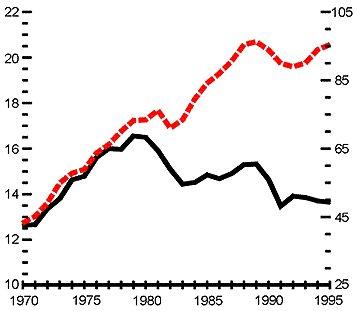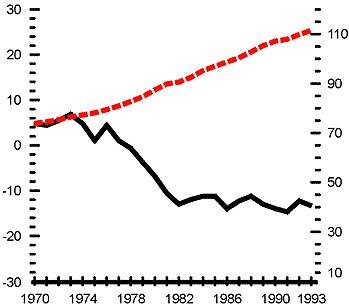 |
| Canada’s Gross Domestic Produce (GDP) is indicated in red; the Index for Social Health (ISH) in black. Source: Human Resources and Social Development Canada, Bulletin of Applied Research, Vol. 3, No. 2 (Summer-Autumn 1997) |
 |
| The american GDP is indicated in red, the indexfor Social Health in black. Source: Human Resources and Social Development Canada, Bulletin of Applied Research, Vol. 3, No. 2 (Summer-Autumn 1997) |
In the United States, the ISH has been measured, on a state-by-state basis, since 1970. To date, the peak value, 69.5, was recorded for the year 1973. Since the economic crash of 1993 (when the value reached a low of 43), the index has slowly risen, but with a value of 54.8 in 2006, it still remains well below the high point reached in 1973.
The search for a single quantitative measure of social well-being resulted in the development of the Index of Social Health (ISH) in 1986 by Marc Miringoff at Fordham University in the United States. The Index focuses on specific social problems, to determine if there has been an improvement or a decline over time.
The Index of Social Health identifies 16 social issues dealing with health, mortality, inequality, and access to services. The indicators are stratified by stages of life.
Children
Youth
Adults
Children
- Infant mortality
- Child abuse
- Children in poverty
Youth
- Teen suicide
- Drug abuse
- High school drop outs
Adults


 The editor of L'Encyclopédie de L'Agora and well known newspaper chronicler and philosopher, analyses actuality through the looking glass of Belonging.
The editor of L'Encyclopédie de L'Agora and well known newspaper chronicler and philosopher, analyses actuality through the looking glass of Belonging.